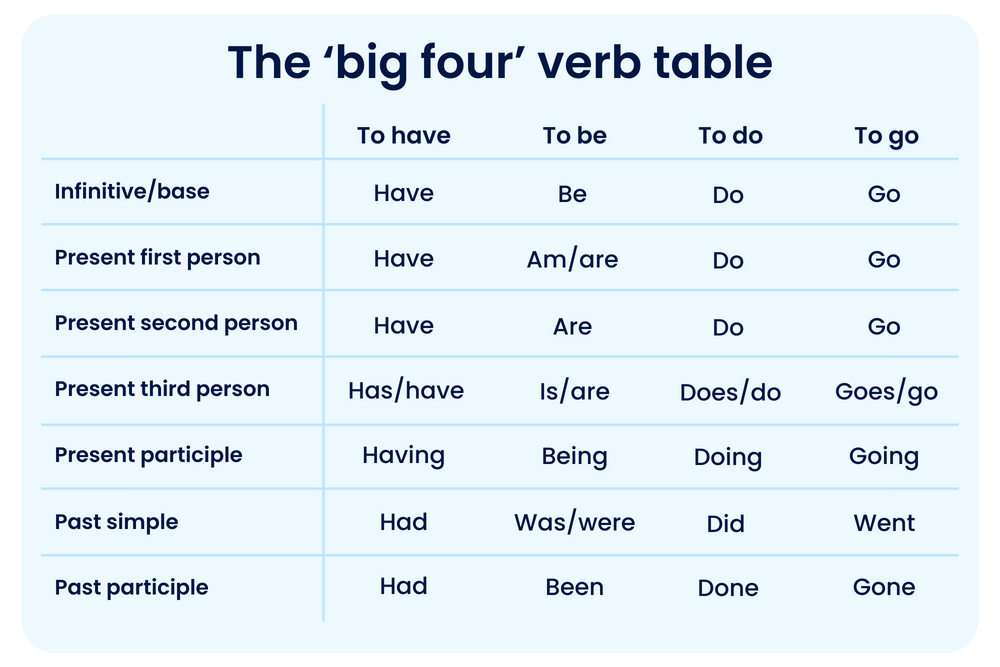Verbs add vital information to sentences. They tell us what is happening, such as what a person or thing is doing or being. They’re an essential part of a sentence but, unfortunately, they come with a lot of rules.
Research shows that nouns tend to be easier to learn than verbs, which has been attributed in part to their imageability as distinct entities, an important driver of learning in early years. However, once students have some noun words in their vocabulary, they need to bring them to life; the best way to do that is through verbs.
What are verbs, and why are they difficult to learn?
A verb is a word that describes an action (I run to school) or a state of being (I am a runner). Every sentence needs at least one verb, and there are thousands of them in the English language, each belonging to different categories that have specific rules. The sheer number of rules behind using verbs is one of the reasons they are so challenging to learn.
Verbs are primarily used alongside a subject, which is a noun or a pronoun representing the person or thing that is doing or being. Different verb forms are required depending on the subject, but also depending on the tense, and this further complicates things.
In the following article, we address common challenges around learning verbs and look at ways to help students remember the many rules.
Common learning challenges around verbs
Regular verbs
With regular verbs, there is a pattern: the simple past tense and past participle are formed in the same way with -ed endings, or -d endings if the infinitive already ends in e. For example, I walk changes to I walked, and I type becomes I typed.
Irregular verbs
With irregular verbs, there is no pattern for the simple past tense and past participle; the only way to learn these forms is by memory. Take ‘drive’ as an example; it becomes drove in the past tense and driven in the past participle.
Dynamic verbs
Also called action verbs, these describe what a person or thing is doing. They are used for external physical activities, such as ‘walk’, ‘swim’ and ‘dance’, as well as for internal mental activities, such as ‘consider’, ‘think’ and ‘guess’.
Stative verbs
Also called state-of-being verbs, these describe what a person or thing is being or feeling. Examples include ‘prefer’, ‘love’ and ‘hate’.
Auxiliary verbs
Also called helping verbs, these link the main verb in a sentence to the subject. They have several uses, including changing tense - for example, I will be at the concert, with ‘will’ acting as the auxiliary verb for the main verb ‘be’ - and creating negative statements, such as I have not gone to the concert, with ‘have’ acting as the auxiliary verb for the main verb ‘gone’.
They can also be added to the front of a sentence to form a question. Did you go to the concert?
Transitive verbs
These are action verbs that transfer an action from a subject to an object. The boy (subject) dropped (verb) the apple (object).
Intransitive verbs
These are also action verbs, but in the intransitive form they do not need an object. They make sense on their own, without someone or something.
Examples of intransitive verbs are ‘arrive’, ‘sneeze’ and ‘die’.
Phrasal verbs
These are formed by adding an adverb or a preposition to an existing verb.
For adverb phrasal verbs, the verb is followed by an adverb that is essential for the meaning of the sentence. For example, the adverb ‘up’ changes the meaning of the verb ‘fed’ to ‘fed up’.
For preposition phrasal verbs, the verb is followed by a preposition that links the verb to an object. For example, the preposition ‘into’ changes the verb ‘run’ to ‘run into’ and would be followed by the object.
Linking verbs and tenses
The verb tense tells us when something has taken place, with three basic tenses – the present, the past and the future. The form of the verb changes according to the tense of a sentence.
There are four or five forms a verb can take. The base form is used to make the infinitive (to laugh) and is also used in the present tense (I laugh), except for the third person singular where a -s ending is required (she laughs).
Regular verbs have -ed endings for simple past tense and past particle (I laughed), while the base form is used for the future along with an additional auxiliary verb (I will laugh).
Tenses start to become complicated when it comes to irregular verbs. They don’t follow a pattern for the past tense and often have an additional ending for the past participle (I ate, I have eaten). Children who grow up speaking English tend to pick these up incidentally through speaking and listening to others. However, where you have English as an Additional Language (EAL) learners, this is particularly tricky and they are likely to need extra support to remember the different irregular verb forms.
Getting to grips with conjugation
Conjugation is changing the verb form to match the tense and the subject of the sentence. We’ve seen above how tense impacts verb form, but the verb must also match the subject or pronoun. The basic rule is: when the subject is singular, the verb is singular; when the subject is plural, the verb is plural. The box is heavy versus The boxes are heavy.
Particulars of pronouns
Indefinite pronouns can usually be identified as singular or plural to follow the conjugation rule. For example, ‘each’, ‘either’, ‘anyone’ and ‘everyone’ are singular; while ‘both’, ‘many’ and ‘few’ are plural. However, there are some that can be singular or plural, including ‘all’, ‘any’, ‘most’, ‘some’ and ‘none’. The prepositional phrase that follows, determines whether the verb form is singular or plural. Most of the food has been eaten versus Most apples have been eaten.
Objects and verbs
The object is the person or thing affected by the action of the verb. Direct objects are directly affected by the verb. In The cat sat on the mat, the ‘mat’ is the direct object. The indirect object is the person or thing that receives the direct object. For example, in The boy gave the cat a mat, the ‘cat’ is the indirect object and the ‘mat’ is the direct object.
Passive versus active
These are often called ‘voices’ and they change depending on the order of the words. In the active voice, the subject performs the verb action, such as The boy fed the rabbit. In the passive voice, the subject receives the action, such as The rabbit was fed by the boy.
Verb patterns
This is the way verbs are used with each other in a sentence to create meaning. A verb can be followed by another verb in the infinitive, such as ‘to do’, or by the -ing form, such as ‘doing’. The form used can have a significant impact on meaning, for example, remember to do versus remember doing.
The ‘big four’ verbs and more
In English, some of the most frequently used verbs that your learners will come across are irregular. This includes the big four, to have, to be, to do and to go, with the first three also the primary auxiliary verbs. It can be useful to provide learners with a list of the verb forms for the most common verbs, starting with the top four as follows.

Activities for teaching verbs
Putting verb rules into practice, using activities such as those below, is a good way to reinforce learning:
- Putting verbs in order - Ask learners to arrange verbs with similar meanings in order of their impact, for example, jog, run, sprint. This is great for helping learners understand the outcome of verb choice.
- Sentence building using verbs - Give learners a random selection of different verb forms and ask them to create sentences. This helps them identify how verb forms relate to other elements in a sentence.
- Changing tenses - Create verb forms for a verb in one tense (for example, the simple present tense for be: I am, you are, he/she is….) and challenge learners to change them to another (for example, the simple past, I was, you were, he/she was…).
- Charades - This works well with dynamic/action verbs in group settings. Create a range of cards, each containing a single verb, and invite learners to pick one at random and act it out while other learners guess the word.
- Tic Tac Toe - Also known as Noughts and Crosses, this is a good team game and can be used to practise a variety of verb rules. Create a team of Xs and a team of Os. Draw the classic grid and write a base verb in each square. Teams take turns picking a square and applying the rule to the base verb to create a sentence. If they get it right, they claim that square, with X or O, depending on their team. The first team to get three in a row wins.
- Spot the mistake - Provide students with a text that includes incorrect verb usage and ask them to find the mistakes.
How Bedrock helps teach verbs
Bedrock's grammar curriculum makes learning fun and takes the effort out of teaching grammar by using engaging experiences. Verb rules are taught through stories, teaching videos, interactive activities and scaffolded writing opportunities to help students understand the impact of different verb rules and improve written accuracy. Learners recap grammar techniques until they have achieved mastery - teachers can use data-driven insights to track progress.



